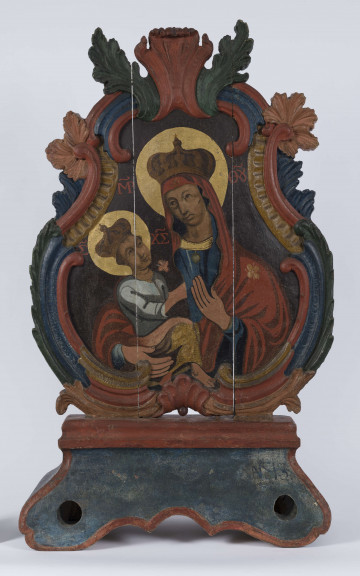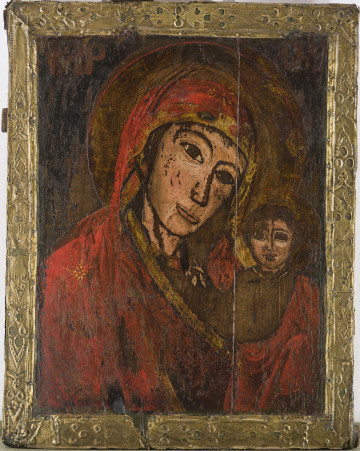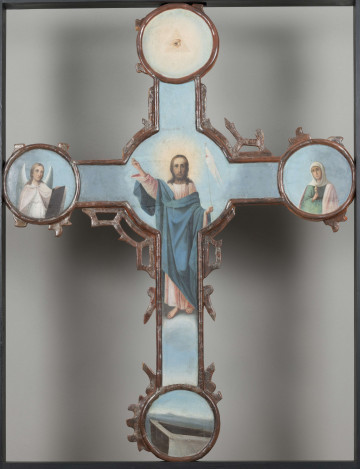
Our Lady of Chełm and Saint Nicholas
1801 — 1900
National Museum in Lublin
Part of the collection: Folk Art of the Lublin Region (17th–1st half of the 20th c.)
Processional images with depictions of saints were and are quite common in Orthodox churches. They are used during processions depending on the circumstances - joyful, supplicatory or funeral, which take place on holidays or are connected to special events. They are an expression of common, solemn, prayer. According to liturgical symbolism, the prototype of the procession is the journey of the chosen people from slavery in Egypt to the promised land. Crosses and procession floats may be carried along with processional images.
An icon is inseparably connected with the culture and religion of the Eastern rite. In Orthodox spirituality, it is an element that enables contemplation and approach to the sacrum, and is therefore a work of prayer rather than art. It is supposed to show inner beauty by spiritualising the painted figure, making his earthly body unreal and showing the divine and sacred nature. Characters were presented in a hieratic posture facing, with eyes staring ahead, allowing direct contact - conversation, prayer with the faithful standing in front of the icon. Movement was shown through gestures reduced to the necessary minimum. Most often there was a gesture of blessing in the portraits of Christ and saints. Raising the right hand or the symbolic arrangement of fingers imitating the monogram of the Almighty additionally sanctified the icon. According to the words of St. Basil the Great, the worship given to the image was to be transferred to its prototype, and the one who worships the image, worships the person depicted.
An important role in the iconic images were robes, which were most often modelled on the clothes of Byzantine dignitaries. The same is true of these icons placed in a metal openwork image case with representations of Our Lady of Kazan and St. Nicholas. Mary, as a married woman, has on her head a covering (maforion) falling on her shoulders, according to the custom of Jewish women of that time. Her head and that of the Infant is surrounded by a radiant nimbus. Saint Nicholas was depicted in the liturgical robes of a bishop. He is thus dressed in a liturgical robe (omophorion) with large crosses, a chasuble (felonion) and a cope (polystaurion) decorated with crosses. His right hand is raised in a gesture of blessing, while his left, partially covered by a fold of his robe, holds a closed Gospel. On a few icons the holy book is sometimes open.
Author / creator
Dimensions
cały obiekt: height: 73 cm, width: 69 cm
Object type
painting
Technique
engraving
Material
lime tree wood
Creation time / dating
Creation / finding place
Owner
The National Museum in Lublin
Identification number
Location / status

1801 — 1900
National Museum in Lublin

1801 — 1900
National Museum in Lublin

1801 — 1900
National Museum in Lublin
DISCOVER this TOPIC
Museum of King Jan III's Palace at Wilanów
DISCOVER this PATH
Educational path